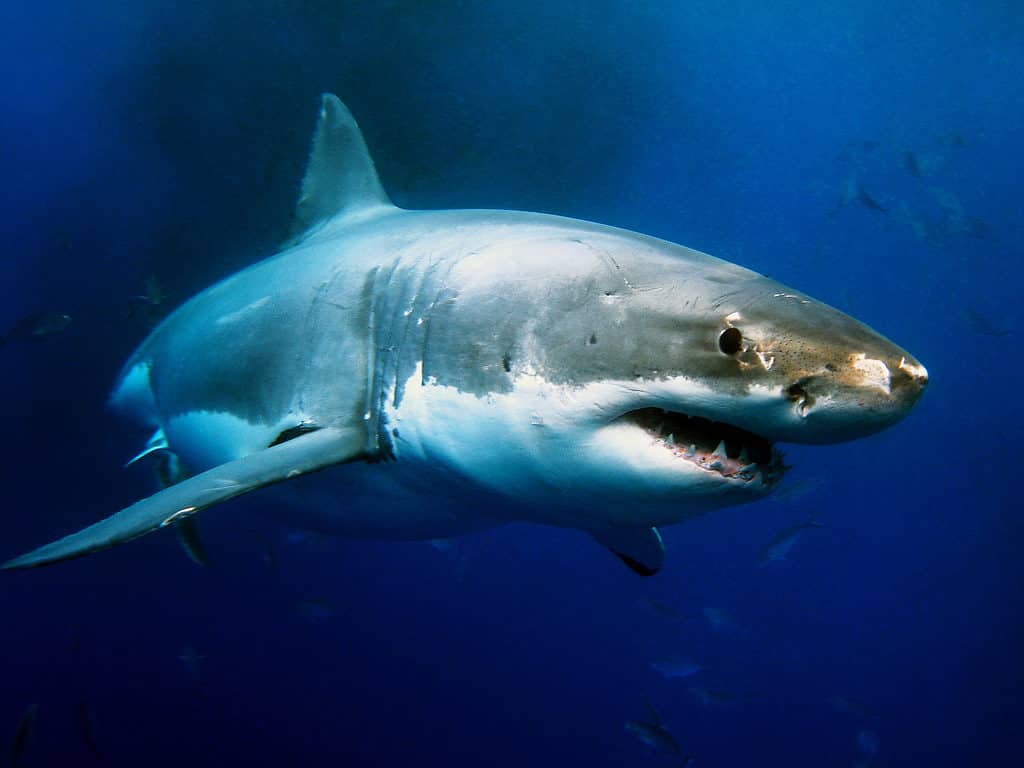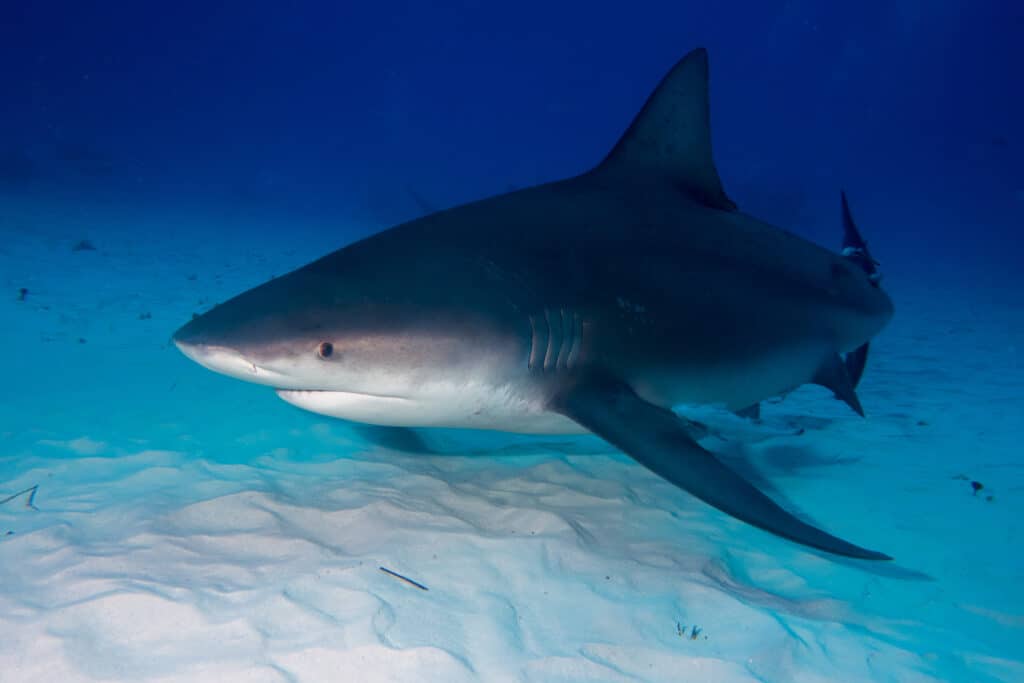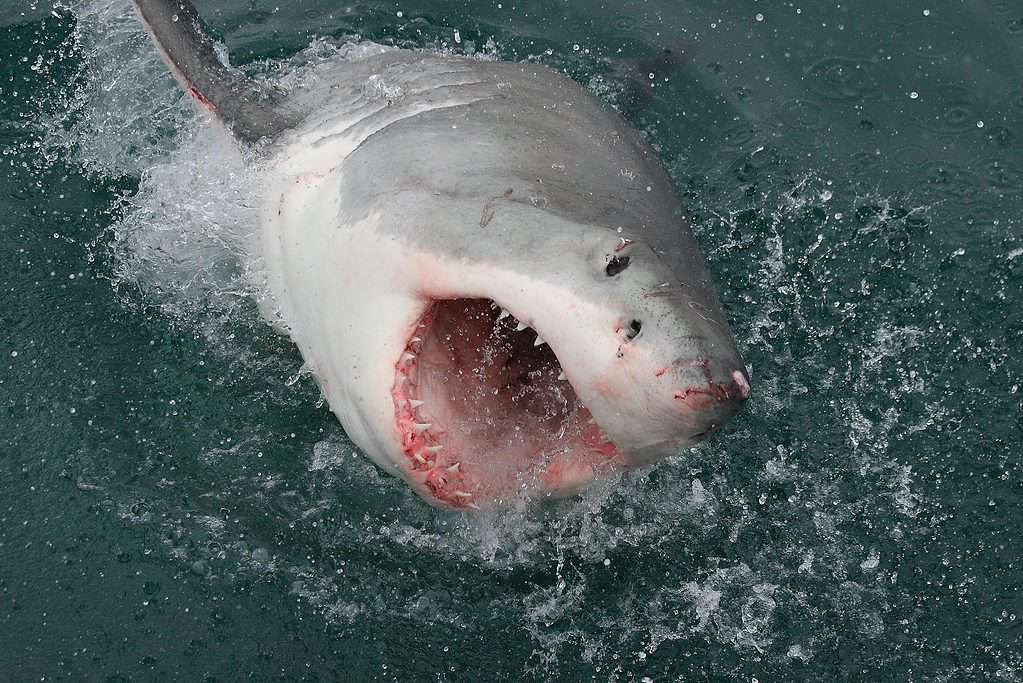Sharks have a rich ancestry dating back 400 million years. Over time they’ve been adapting to the ocean environment with refined senses, including sight, smell, hearing, touch, taste, and electromagnetism. But not all sharks are created equal. A lot sets shark species apart, such as size, strength, and hunting skills.
This article will compare two formidable shark species; the bull shark and the great white shark. By comparing their strengths and weaknesses, we can guess who might win in a bull shark vs. great white shark showdown.
Key Points: Bull Shark vs. Great White Shark Battle
- Bull sharks live worldwide in coastal waters and can survive in both freshwater and saltwater environments.
- Great white sharks live worldwide in subtropical and temperate waters, with nurseries along specific locations.
- Bull sharks have a light gray or brown top that fades into a whitish belly.
- Great white sharks have a dark gray back that transitions to a white belly.
- Bull sharks possess the greatest biting force among all shark species.
- Great whites rely on speed and agility in hunting.
- Bull sharks use a bump-and-bite technique and have a broad diet that includes fish, other shark species, birds, turtles, and marine mammals.
- Great white sharks exhibit breaching behavior and have a sensory system that helps them detect electrical fields produced by potential prey.
- Bull sharks have quick bursts of speed and are influenced by food availability and water temperature.
- Great white sharks can reach high speeds and undertake long-distance migrations for various purposes.
Competitor Overview
The key factors in a bull shark vs. great white battle are appearance, bite force, hunting skills, and speed. Over three rounds of fighting, we’ll compare these key factors to see which shark has the advantage. It might seem like an easy win for the great white, but bull sharks are much stronger than most people realize.
Bull Shark

Bull sharks live in coastal waters, including the US East Coast and the Gulf of Mexico.
©Harry Collins Photography/Shutterstock.com
The bull shark, responsible for at least 100 unprovoked attacks on humans, is a powerful creature. These sharks are found globally in coastal waters, including the US East Coast and the Gulf of Mexico. They possess special glands and kidney functions, enabling them to survive in fresh and saltwater environments. Their natural predators include tiger sharks, sandbar sharks, and even crocodiles.
Great White Shark

Great white sharks are the ocean’s apex predators.
©iStock.com/Whitepointer
On the other hand, great white sharks live worldwide in subtropical and temperate waters. Nurseries for great whites are located along Southern California and off Long Island, New York. Their habitat preferences change with age, as juveniles prefer staying near the shore while older individuals split their time between sea lion colonies and pelagic habitats. Despite their widespread presence, much remains unknown about their life history, behavior, and movements.
Round 1: Appearance

Bull sharks gradually change color from their gray back to white underbelly.
©HakBak/Shutterstock.com
For round one of our animal battle, we’ll compare these sharks’ appearances. While both species share a similar color, it is possible to tell them apart. It’s all about looking for the sharp color transition from their back color to their underbelly.
Bull sharks have a light gray or brown top that gradually fades into a whitish belly. The key word here is gradual; it’s not a stark color contrast. As for size, males typically reach about 7 feet in length, while females can grow up to 11ft.
On the other hand, great white sharks have a dark gray back that quickly transitions to a stark white belly. It’s a noticeable color change, there’s nothing gradual about it. Their backs are much darker than their white bellies.
Great whites spend a lot of their life growing up. Males don’t mature until they’re 26, while females mature at 33. These sharks can reach up to 20 feet, nearly three times the size of an adult male bull shark. And in some cases, they can get even bigger!
The largest recorded great white shark, a female named Deep Blue, measured 20 feet in length and weighed approximately 4,500 pounds. If the bull shark had to fight this beast, it’d definitely lose!
Now you know how to tell these sharks apart and their different sizes. That means it’s time to move into our next round of this animal battle.
Round 2: Bite Force and Hunting Skills

Great white’s bite force of around 4,000 PSI is weaker than the bull shark’s bite force of around 1,350 PSI.
©Alessandro De Maddalena/Shutterstock.com
We’ll look at each shark’s biting power as we kick off round two. Can you guess who has the stronger bite force for this animal showdown? If you guessed bull shark, you’re right!
Pound for pound, bull sharks possess the greatest biting force among all shark species. A nine-foot-long bull shark can deliver a bite force of up to 4,100 PSI, surpassing the bite force of an eight-foot-long great white shark, which measures around 1,350 PSI.
Both bull sharks and great white sharks sit at the top of the food chain, with few natural predators. Most of their life is spent looking for food rather than avoiding becoming it.
While adult bull sharks usually hunt alone, they occasionally pair up, utilizing a bump-and-bite technique to deceive and overpower their prey. Their sharp sense of hearing, efficient at detecting sounds within the 400 to 600 Hz range, helps them find food up to 20 feet away. Their diet includes fish, other shark species, birds, turtles, and marine mammals.
Great whites use a breaching technique, swimming at high speeds from deep waters to surprise their prey. Their unique sensory system lets them detect electrical fields produced by potential prey, enabling them to locate camouflaged food. Additionally, their excellent vision is crucial in accurate prey location and attack.
What does a great white shark eat? All sorts of food, with seals being a specialty. However, it’s not always easygoing for these apex predators.
Great white sharks face challenges in hunting, as observed during a 78-day study where researchers recorded only two feeding bouts. These sharks were observed hunting seals near seal colonies, with some individuals exhibiting parallel movements along the shoreline.
Round 3: Speed

Bull sharks can swim 11 mph over short distances.
©iStock.com/Divepic
It’s the last round of our bull shark vs. great white shark animal battle. So far we’ve compared each species’ appearance, size, and biting power. But what about their ability to swim? In an animal battle, being able to outswim your competitor can be a major advantage. That’s why round three is all about speed.
Bull sharks are capable of quick bursts of speed, reaching over 11 mph during short distances. Their movements are influenced by food availability, water temperature, and reproductive behavior. Female bull sharks, for example, migrate to estuaries in shallow coastal areas to give birth, as these areas provide protection for their offspring.
In terms of speed, the great white shark takes the win. Great whites can swim up to 50 mph, making them much faster than their foe.
Great whites are also the champions of endurance. They’re known to undertake long-distance migrations, traveling thousands of miles for various reasons such as breeding, feeding, and searching for optimal water temperatures. Some individual great white sharks have been tracked, migrating over 12,000 miles. The migration patterns and distances between male and female great white sharks can differ.
Who Wins?
The great white shark emerges as the winner. While bull sharks excel in bite force and adaptability to different water types, great whites possess superior speed and size. With their incredible speed, size, and strength, great white sharks would have the advantage in a head-to-head encounter with bull sharks.
However, it is important to note that bull sharks are generally more dangerous when considering the threat these sharks pose to humans. Their aggressive nature has led to more reported cases of bull shark attacks on humans than great white sharks. And despite their notoriety and potential dangers to humans, they play vital roles in maintaining the health and balance of marine ecosystems.
Continued research and conservation efforts are crucial to protect these remarkable species. Both bull sharks and great white sharks are vulnerable to human activities such as overfishing and habitat degradation.
The photo featured at the top of this post is ©
Thank you for reading! Have some feedback for us? Contact the AZ Animals editorial team.






